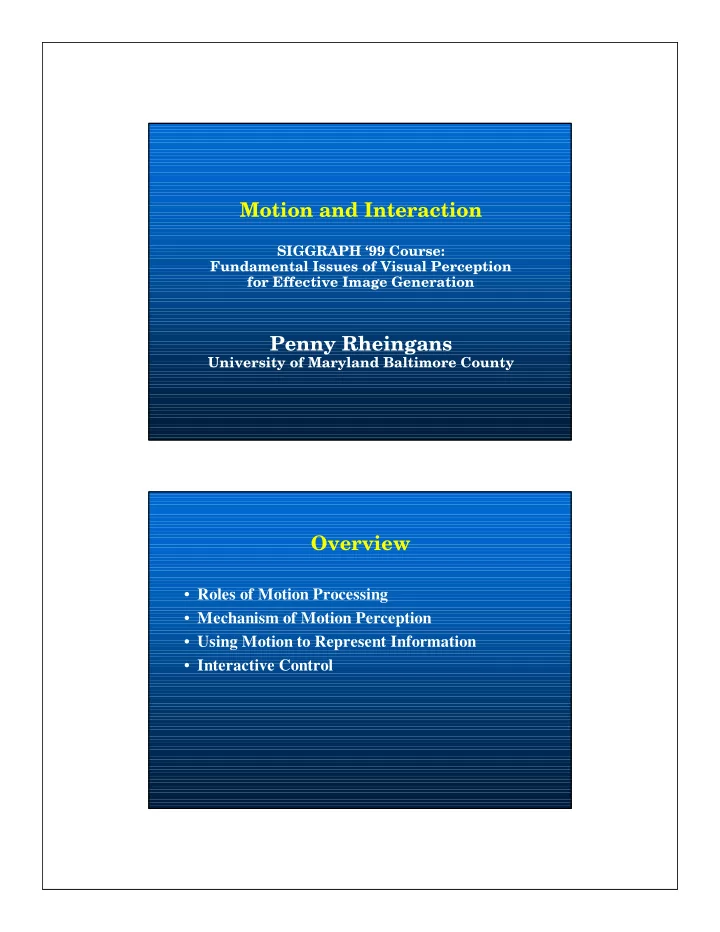

Motion and Interaction SIGGRAPH ‘99 Course: Fundamental Issues of Visual Perception for Effective Image Generation Penny Rheingans University of Maryland Baltimore County Overview • Roles of Motion Processing • Mechanism of Motion Perception • Using Motion to Represent Information • Interactive Control
Roles of Motion Processing • Required for Pattern Vision • Driving Eye Movements • Time to Collision • Exproprioceptive Information • Perception of Moving Objects • Depth from Motion • Encoding 3D Shape • Image Segmentation Characteristics of Motion Perception • Fundamental, independent visual process – motion aftereffects – motion blindness • Based primarily on brightness • Ability to interpret structure degrades in periphery • Spatio-temporal interactions
Motion Pathway • Red and green cones • Type A retinal ganglion cells • Magnocellular layers in LGN • Area 4B in primary visual cortex – direction selectivity – velocity selectivity – expansion/contraction of visual field – global rotation • Middle temporal lobe Magnocellular Division • Discriminates objects from one another • Characteristics (relative to parvocellular path) – color : insensitive to wavelength variations – acuity : larger RF centers – speed : faster and more transient response – contrast : more sensitive to low contrast stimuli • Observed characteristics of motion perception – color-blind: impaired at equiluminance – quickness – high contrast sensitivity – low acuity : impaired at high spatial frequencies
Apparent Motion • Def: perception of motion without stimulus continuity (stroboscopic and cine) • Influences – spatial frequency characteristics – global field effects – number of frames – expectations from reality • Limitations – maximum of 300 msec interstimulus interval – decreased size constancy (max ~8 Hz) – decreased sense of observer motion
Depth from Motion • Motion depth cues – head motion parallax – kinetic depth effect – magnitude of motion indicates relative depth • Applications – indicating relative object positions – compensating for lack of other depth cues • Limits – relative, not absolute depth – perceived size, perceived depth related Head Motion Parallax • Bruce and Green ‘90, p. 231.
Kinetic Depth Effect • Bruce and Green ‘90, pg. 162.
3D Structure from Motion • Relative motion conveys info about 3D shape • Rigidity assumption • Applications – understanding of irregular/unfamiliar shapes – disambiguation of 2D projections • Limits – 2 frames (large number of structured points) – 2-3 points (many frames) – 15 arc min (maximum displacement) Structure from Motion • Bruce and Green ‘90, pg. 328.
Image Segmentation • Discontinuities in optical velocity field indicate object boundaries • Boundaries can be detected on the basis of motion alone • Applications – disambiguation of complex scenes – grouping of similar objects
At Equiliminance • Motion perception of gratings degrades • Depth perception disappears • Depth from relative motion disappears • Shape from relative motion disappears Interaction vs. Animation • Exploration vs. Presentation – efficiency – flexibility • Active vs. Passive Participation – immediacy – control – development – understanding
Interactive Control • Scene – viewpoint and direction – object position and orientation • Content – variables – timestep • Representation – techniques – parameters Experimental Findings • Control necessary for development – Held and Hein ‘63 • Dynamic control improves shape identification – van Damme ‘94 – Rheingans ‘92, ‘93 • Control inproves assembly performance – Smets and Overbeeke ‘95 • Differences between types of control – Ware and Francke ‘96
Kitten Carousel • Held and Hein ‘63. Experimental Findings • Control necessary for development – Held and Hein ‘63 • Dynamic control improves shape identification – van Damme ‘94 – Rheingans ‘92, ‘93 • Control inproves assembly performance – Smets and Overbeeke ‘95 • Differences between types of control – Ware and Francke ‘96
Shape Identification • van Damme ‘94, p. 18. Effects of Control Control None Pace Complete Slide Slide Jerky Interactive Show Projector Change Constant Multispeed Smooth Dynamic Loop Loop • Rheingans ‘92, ‘93, ‘97.
Experimental Findings • Control necessary for development – Held and Hein ‘63 • Dynamic control improves shape identification – van Damme ‘94 – Rheingans ‘92, ‘93 • Control inproves assembly performance – Smets and Overbeeke ‘95 • Differences between types of control – Ware and Francke ‘96 Assembly Performance • Smets and Overbeeke ‘95, p. 47.
Experimental Findings • Control necessary for development – Held and Hein ‘63 • Dynamic control improves shape identification – van Damme ‘94 – Rheingans ‘92, ‘93 • Control inproves assembly performance – Smets and Overbeeke ‘95 • Differences between types of control – Ware and Francke ‘96 Type of Control • Ware and Francke ‘96, p. 122.
Avoid • Moving objects without clear boundaries • Combining movement (of object or viewpoint) and shape change • Motion without reference cues • Mismatched spatial and temporal frequencies • Temporal aliasing
Recommend
More recommend